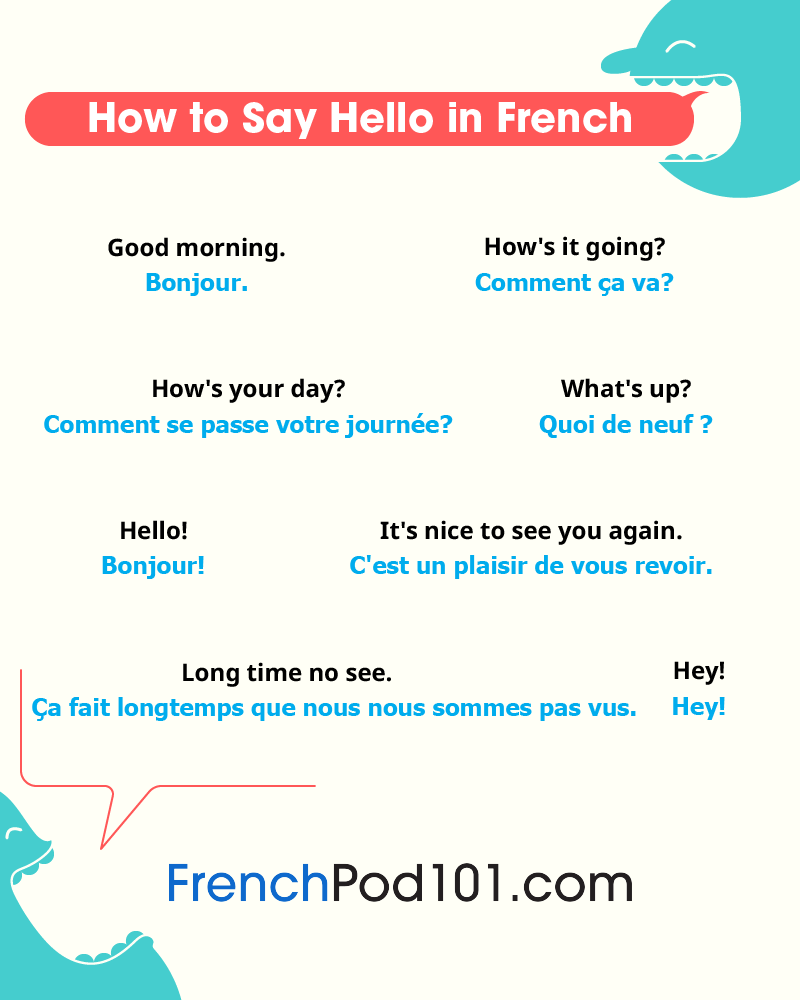We all know the importance of first impressions, but do you know how long it really takes for a person to make a judgement and put you in a mental box from which you might never get out? According to psychologists and communication experts, it’s around five seconds, just enough time to walk down the hall and say “Hello” or “Good morning.” Hence, choosing the proper greeting is the best way to make you sound fun and engaging to your friends, or professional and trustworthy to your business partners.
It’s even more important with French, as we can be pretty intense about manners and social “etiquette.” No wonder, we even invented the word. So, if you want to learn how to say hello in French as naturally as native speakers would and learn everything about greetings in French, buckle up and follow this French greetings guide!
1. “Bonjour” and “Salut,” Your French Bread-and-Butter
Wish there was a magic word to get you through 95% of your social encounters when it comes to saying “hello” or “good morning” in French? You’re in luck, there are two generic ways of how French greet!
- Bonjour (“Hello”) is as fail-proof as it gets. Literally, “Good day” (Bon jour), it can be used all morning and afternoon, with anybody, in any kind of situation. The beauty of Bonjour is that it’s neither too formal nor too relaxed; you cannot go wrong with it.
- Salut (“Hi”) is the casual bonjour that you use with friends and peers. It’s short, cheerful, easy to pronounce, and you can use it all day long. And the best part? You can also use it to say “Bye!”
2. Greeting Like a Boss!
Now that you have the basics, let’s get to the juicy part and learn some specific greetings.
- Coucou (“Hey”) is an odd bird, quite literally. Coming from the “cuckoo” bird sound, it’s a way to attract attention in a naïve and childish manner. One cannot get less formal than using Coucou, and it’s common in use between romantic partners or with close friends or family. If you want to sound cute or playful, Coucou is right for you and is an excellent French greetings for between friends.
1- Time-dependent Greetings:
- Bonsoir (“Good evening”) takes over when it’s too late to say Bonjour. Literally “Good evening” (Bon soir), you can use this French greeting after sundown. Don’t worry, nobody will ever get offended if you get you bonjour and bonsoir mixed up!
- How to say “Good morning” in French? We don’t! Unless you’re in Quebec, where French speakers use Bon matin. Better not use it in France, though, as it may sound quite awkward to an unprepared French audience.
/! Bonne matinée, Bonne journée, and Bonne soirée (Literally: “Good morning,” “Good day,” and “Good evening”) may sound like greetings, but they are only used to say goodbye!
2- Phone and Online Greetings:
- Allo? (“Hello?”) is only used for answering the phone in French, as a question, to make sure your interlocutor can hear you. Use it either at the start of the conversation or if you suspect the call might have dropped.
If someone ever greets you in the street with a Allo, check your GPS: you’re most likely in Quebec where Allo is used for Bonjour while Bonjour? starts a phone conversation. Yeah, it’s slightly confusing.
- Cc, yop, and plop (“Hi”) can be used in online games and chat. Cc is short for Coucou (“Hey”), while yop and plop are just sounds.
3- The Magic of “Nice to Meet You”
Once you’ve met someone for the first time, you might want to add a polite or charming “Nice to meet you.” It can take many forms, but the most common and simple is:
- Enchanté (“Delighted”), which can be used for anybody, anytime, anywhere.
If you want to sound fancier or display your French knowledge, you can choose to use one of these:
- Ravi de vous rencontrer or Heureux de vous rencontrer. (“Happy to meet you.”)
- C’est un plaisir de faire votre connaissance. (“It’s a pleasure to make your acquaintance.”)
- C’est un plaisir de vous rencontrer. (“It’s a pleasure to meet you.”)
It can be cut down to Un plaisir de vous rencontrer (“Pleased to meet you”) or even Un plaisir (“A pleasure”). Sprinkle it with a charming smile and it can take you a long way!
3. How to Say “How are You?” in French
Now that you’ve said “Hello,” it’s time to break the ice and give some honey to whoever you’re talking to. With a simple “How are you doing?” or “What’s up?” you can be polite, show your interest, or even spark a conversation.
- Comment allez-vous ? [Formal] / Comment vas-tu ? [Casual] (“How are you doing ?”)
Literally “How are you going?” this is the easiest way to inquire about someone’s well-being. Other popular casual forms are Comment ça va ? (“How is it going?”) or Tu vas bien ? (“Are you good?”).
The typical follow-up is Ça va (“It goes”), a foolproof noncommittal answer. But you can make it a bit more personal with Ça va bien (“It’s going well”) or with the world-famous Comme ci comme ça (“So-so”) which literally means “Like this, like that.”
- Quoi de neuf ? [Casual] (“What’s new?”)
There are no standard follow-ups for this one, so you’ll have to come up with a genuine answer and curse your interlocutor for making your life so hard!
4. Tu or Vous: A Lesson in French Etiquette
Formal or casual? You have to choose it wisely, as French can be slightly more demanding with manners than in other aspects of the language.
1- Choose a “You”
The French have two distinct pronouns for “You”: Vous and Tu (formal and casual “You”), and each new encounter gets a bit trickier when you have to choose one. We can imagine how horrible it seems to English speakers, but it’s easier than it seems and even has some perks!
In a nutshell, here’s how it works:
- Friends, peers, family, kids, or teens, someone younger than you, and animals: Tu
- Anybody else: Vous (until decided otherwise by both parties)
- Whenever in doubt: Vous
See? Not so much of a headache!
When you feel comfortable enough, you can use Tu with strangers in informal situations (in a bar, club, or hostel), and anyone using Tu with you allows you to do the same. It’s also an interesting way to gauge your level of intimacy with someone.
2- Choose a Title
If you go for a formal greeting, you can add a title, but it’s not mandatory. It might come as a shock after the previous section, but there’s nothing complicated about titles. Hurray!
- Monsieur (“Mister”)
- Madame (“Madam”)
- Mademoiselle (“Miss”)
3- Formal and Casual Greetings
So, if we put everything together, what does it look like? Here are two examples of greeting conversations in French to help you figure it out:
[Formal] Julien meets Sebastien Laroche in a business meeting.
- Julien: Bonjour Monsieur Laroche. (“Hello Mr Laroche.”)
- Sebastien: Bonjour ! (“Hello!”)
- Julien: Comment allez-vous ? (“How are you doing?”)
- Sebastien: Ca va bien, merci. (“I’m good, thank you.”)
In this formal setting, Julien opens with the universal Bonjour, followed by the title Monsieur to show his respect. Then, he continues with a polite Vous. Maybe when they get comfortable enough, they will switch to the Tu.
[Casual] Julien meets his friend Cédric.
- Julien: Salut ! (“Hi!”)
- Cédric: Salut Julien ! (“Hi Julien!”)
- Julien: Tu vas bien ? (“How are you doing?”)
- Cédric: Ça va. (“All good.”)
Julien addresses his friend with a friendly Salut (“Hi”) and uses the casual Tu throughout the conversation.
5. Spice it Up with a Pinch of Slang!
Now that you know how to casually say “hello” in French, what about sounding even cooler with some slang? Here are some fun ways to say “hi” and impress your French friends with your laid-back fluency!
- Yo! (“Hi”)
- Wesh? (“Hi”)
This one comes from the Algerian Wesh rak (“How are you doing?”) and became increasingly popular in recent years, even though it’s frequently frowned upon.
- Ça fait un bail ! (“Long time no see!”)
- La forme ? (“How are you doing?”) — Literally “the shape?” from “Are you in good shape?”
- Bien ? (“Are you doing well?”) — Literally “Good?”
- Ça roule?, Ça gaze?, and Ça biche? are tough to explain, but all mean the same as Bien ?
6. The Secret Art of French Kissing
No more vocabulary here, it’s time to get physical and learn about kissing. But despite this deceiving chapter’s name, there won’t be any tongue involved! French greetings body language is one of the most vital aspects of the language as a whole, so without further ado, let’s talk about the most typical, infamous, and confusing feature of French etiquette: La bise.
1- Shaking Hands
Hold on! Before the kissing part, let’s get the classic and manly handshakes out of the way. Yes, we shake hands in France. We do it vigorously, with a firm hand while looking straight into each other’s eyes. You can shake hands with your friends, your father-in-law, every day with your co-workers, your boss, a friendly bartender, or really anybody you meet for the first or hundredth time. Shaking hands is still the most popular French greeting, by far.
2- Do We Hug in France?
Not really. Some people do, but many also tend to become uncomfortable, stiff, and clumsy when hugging is involved. We actually don’t have a word for friendly hugging and it’s usually kept for close family and romantic partners.
3- Fake-kissing with “La Bise”
In French, the word Bise refers to a kiss on the cheek. Applied to our typical daily greeting, it can be a weird, confusing, or even stressful moment for unsuspecting foreigners. Any gender combination can practice La bise, no matter their age, beliefs, or sexual orientation: this is a friendly greeting. La bise isn’t really a kiss, it’s just a way to say “hello” in French.
Its origins are unclear, but it’s believed to have become prominent sometime after the Social Revolution and Moral Emancipations of May 1968, even though many similar greetings can be found throughout the country’s history. Nowadays, kids start doing and receiving la bise from a young age, and it’s practiced among all social circles. You may have seen photos of our Presidents voraciously kissing German Chancellors or First Ladies alike!
4- How-to Faire la Bise
To do la bise (Faire la bise), you lean forward and touch cheeks with the other person while mimicking a kiss (with the sound and lips gesture). There’s no actual lips-to-cheek contact during the typical bise, just a slight brush of the cheeks. Then, switch cheeks and repeat the same process on the other side.
Pro-tips:
- Some people tend to exaggerate the kissing sound, producing a loud “Mwuaah” on each side, but there’s a good chance you’d be made fun of, if you do so.
- Make sure you don’t “air-kiss” by doing la bise without any cheek contact. Even though your lips are kissing the air, the cheeks should touch.
What Side? How Many?
Brace yourself and don’t panic. Although somewhat codified, la bise is a friendly greeting that shouldn’t be tainted with distress!
- Should you start with the left or right side? Doesn’t matter! If you’re not sure, just follow the other person’s lead and go with the flow.
- How many kisses? Well…it depends. Most French make two, southeasterners make three, while some regions are governed with the rule of four. If it escalates up to five or further, I’d get suspicious!
Yeah, it can get confusing when you’re mentally prepared for two while the other person keeps going up to four, but nothing one cannot handle. Just adapt to whatever comes and always accept that more bises could be hiding around the corner!
You can even find some statistic maps for la bise, but don’t take them too seriously!
To Bise or not to Bise?
Now for the most important question: Should you do la bise or not?
Let us break it down for you:
- If you’re a woman, you can do la bise with friends, family, or peers, no matter their gender, and vice-versa.
- As a man, you can do la bise with female friends, family, or peers, or female strangers met in an informal context.
- As a man, you can also do la bise with your male friends and family, but it usually takes a higher level of intimacy and some people just don’t do it.
It might seem easier for women, but it’s not! When joining a big group of male and female co-workers, for instance, men can just do la bise to women and shake hands with men. Women, on the other hand, are somehow expected to do la bise to everyone. In my experience, however, it’s perfectly fine to just wave or shake hands. If anybody gets offended, they’re just not worth your time.
When joining a group of friends, you may have to do la bise to every single one of them and repeat the same social ritual when you leave. It might sound tedious, but with practice you’ll become fluent with la bise and greet everyone in no time!
Oh, and never be pushy! If you go for la bise and the other person doesn’t mirror your leaning movement or give you their hand to shake, just pack up your bise and don’t get bitter! While in France, you can just let your French hosts take the initiative and follow their bise habits.
7. How FrenchPod101 Can Help You Learn More French
You’ve learned how to say “Hello” in French and to rival with native speakers using fancy greetings and cool slangs. Together, we’ve unraveled the mysteries of la bise and you’re now ready for any casual or formal French encounter at any time of the day!
Next time you bump into a French person, offer them your most graceful Salut ! or Bonjour and see what happens next. Or why not prepare short dialogues to practice, and get comfortable with the Tu and the Vous?
FrenchPod101 has many resources, such as vocabulary lists, to help you improve your French in no time. You can download them for free from our website! Check out our list of Common ways to say “Hello” with audio recordings to practice your accent.
Thank you and we hope that you enjoy learning French with us! Now take your knowledge from this French greetings guide, get out there, and make the most of your new French language skills!














